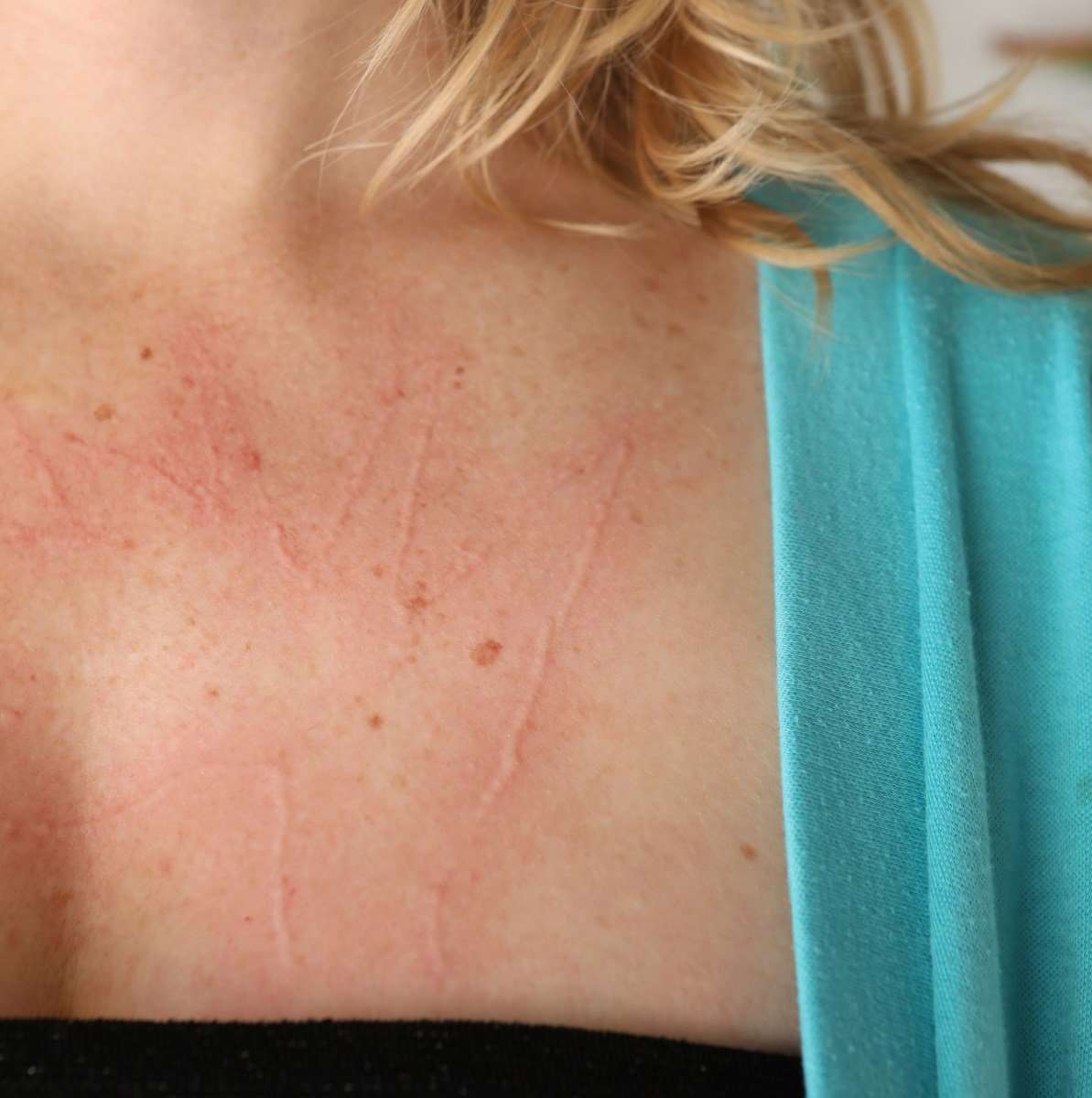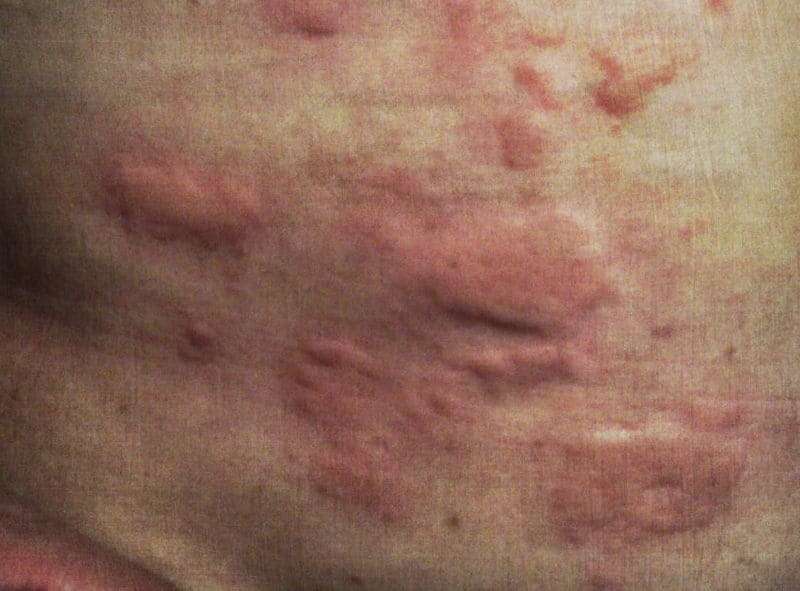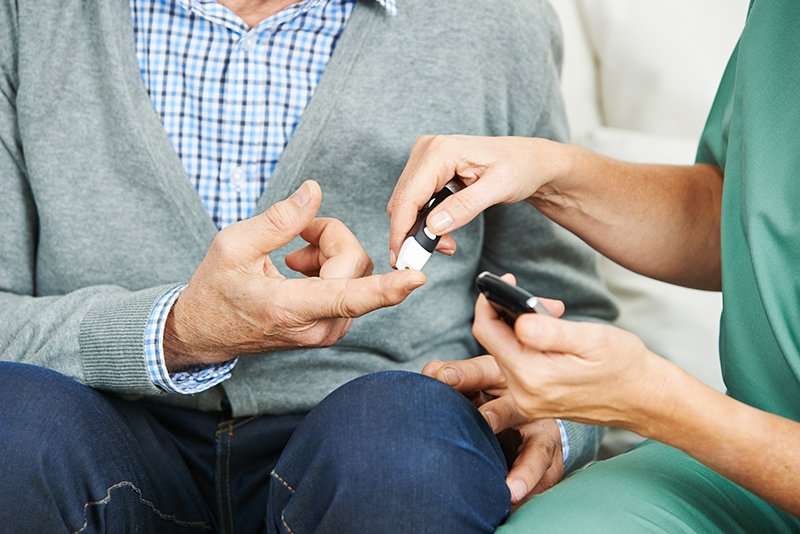The Other Abcde Warning Signs Of Melanoma Are:
- Asymmetry most melanomas are asymmetrical
- Border the border may be irregular, perhaps with scalloped or notched edges
- Color instead of being uniform, the color may vary from one area to another, with shades of tan, brown or black in later stages, red, white or blue may appear
- Diameter melanomas may be smaller when they first appear, but if a mole is the size of a pencil eraser or larger, pay extra attention.
Melanomas tend to have at least one ABCDE trait and may have several. Melanoma can develop in an existing mole or appear as a new mole. It can occur anywhere on the body not just where the sun shines.
While itching can be a sign of melanoma, its more often associated with two other common types of skin cancer: squamous cell carcinoma and basal cell carcinoma.
Squamous Cell Carcinoma Signs And Symptoms
Generally found on the ears, face and mouth, squamous cell carcinoma can be more aggressive than basal cell. Untreated, it may push through the skin layers to the lymphatic system, bloodstream and nerve routes, where it can cause pain and symptoms of serious illness.
Appearance
Squamous cell cancer often starts as a precancerous lesion known as actinic keratosis . When it becomes cancerous, the lesion appears raised above the normal skin surface and is firmer to the touch. Sometimes the spot shows only a slight change from normal skin.
Other signs include:
- Any change, such as crusting or bleeding, in an existing wart, mole, scar or other skin lesion
- A wart-like growth that crusts and sometimes bleeds
- A scaly, persistent reddish patch with irregular borders, which may crust or bleed
- A persistent open sore that does not heal and bleeds, crusts or oozes
- A raised growth with a depression in the center that occasionally bleeds and may rapidly increase in size
Cancers That Cause Cancer Itch
Although most itching is not caused by cancer, there are some times when itching may indeed be one of the many cancer symptoms. If you experience intense itching and it is not relieved with lotions, antihistamines or avoiding your allergens, call your doctor to seek advice.
Some common cancers that can cause cancer itch are the following. The most common cancers to cause itching are hematological malignancies such as Hodgkins lymphoma, leukemia, cutaneous T-cell lymphoma and biliary malignancies. In cases when the itching is chronic and there are no skin changes, a cancer needs to be considered. Here are some cancers that can cause itching:
Recommended Reading: Is Melanoma Caused By The Sun
So Is Basal Cell Carcinoma Itchy
They very well could be. The fifth common warning sign is described as:
- Reddish patch: this could be an irritated area as well. The patch may form a crust, or it starts to hurt or itch. But sometimes it just exists without any discomfort.
Make sure to perform regular self-checks. Start by joining the SkinVision program and download the app as a first step which enables you to check for early skin cancer signs.
Itching Due To Cancer Treatments

There are many cancer treatments that can lead to itching. The most common include some targeted therapies and some immunotherapy drugs, especially interferon and interleukin-2. Many medications can also cause allergic reactions or inflammation of the liver, which in turn, can lead to itching.
Radiation therapy commonly causes itching, especially later on in treatment when the skin begins to heal.
Recommended Reading: Is Squamous Cell Carcinoma Contagious
What Skin Cancers Look Like
Many melanomas begin as a new skin development on unmarked skin. The development might change color, shape, or size. These types of modifications are an early sign that the development is melanoma. But melanoma can likewise establish in an existing mole or other mark on the skin. Or it may resemble a swelling that isnt really healing or appear as a brown or black streak under a fingernail or toenail.
Melanoma can grow anywhere on the body. It most often occurs on the upper back in men and women and on the legs in women. Less typically, it can grow in other places, such as on the soles, palms, nail beds, or mucous membranes that line body cavities such as the mouth, the rectum, and the vagina.
On older people, the face is the most common location for melanoma to grow. And in older men, the most common sites are the neck, scalp, and ears.
Why Might A Mole Be Itchy But Not Painful
There are many different reasons why a mole could be itchy but not painful, and cancer is possible but not the most probable cause. Itching is caused when your skin’s nerves are irritated. This irritation could be caused by chemicals that are applied to your skin, dry skin, peeling skin caused by a sunburn, and other reasons. However, an itchy mole could also be from changes within the mole itself, and changing moles need your attention.
Don’t Miss: What Does Basal Cell Carcinoma Look Like When It Starts
Side Effects Of Stem Cell Transplant
Some people with lymphoma have an intensive type of treatment called a stem cell transplant. This is usually used for people who have lymphoma that has come back or that is at a high risk of relapsing. Most stem cell transplants for people with lymphoma are autologous stem cell transplants, which use your own stem cells. However, a few people have allogeneic stem cell transplants, using stem cells from a donor.
A common complication of an allogeneic stem cell transplant is graft-versus-host disease . GvHD happens because your new immune system recognises your other body cells as foreign and attacks them. GvHD can cause rashes and tightening of the skin. Sunlight can worsen rashes caused by GvHD. Your doctor might therefore advise that you limit the time you spend in the sun.
Do You Have Suggestions For Patients Who Are Experiencing Dry Itchy Skin
Many cancer treatments can cause or worsen dry skin because they slow down the skins ability to renew itself.
Look for creams and ointments, which are generally more effective than lotions at retaining moisture, and select products that are fragrance free. These should be applied at least twice a day, preferably within 15 minutes after showering or bathing. Try not to stay in the shower too long, use lukewarm or warm water instead of hot, and avoid scrubs or loofahs, which can strip away natural oils and contain many bacteria after repeated use.
If your skin is itchy, be sure to tell your healthcare team so they can help you select the best treatment. It is important to use fragrance-free soaps, creams, and detergents. And avoid scratching, even though it may be difficult. Look for over-the-counter creams that contain anti-itch substances such as menthol, camphor, or pramoxine, or consider taking an oral antihistamine.
Also Check: How Quickly Can Melanoma Appear
How Often Should I Have My Skin Checked By A Doctor
An annual skin screening from a board-certified dermatologist is important, especially if you have a large number of moles, other risk factors for skin cancer or live in a place where the sun shines year round . Annual skin screenings may identify skin cancer early, when its more easily treated. If you have a history of melanoma, your dermatologist may want to see you more than once a year.
Between professional skin screenings, its a good idea to periodically check your skin for any new signs of skin cancer. The American Cancer Society shows you how to perform a skin self-exam.
Side Effects Of Radiotherapy
If you have radiotherapy, the skin in the treated area can become pink, dry and itchy. Dark skin might become darker. Rarely, the skin can become blistered, a bit like sunburn. This is more likely in folds of skin, such as under the breasts, in the groin or armpits avoid using deodorants and anti-perspirants under your arms until these problems have cleared up.
Skin reactions are usually at their worst a few days after finishing radiotherapy treatment. Your skin then starts to heal. Speak to a member of your radiotherapy team if you have broken skin in the treated area. They might offer you a soothing gel to apply.
Radiation recall is a rare side effect of radiotherapy. It causes redness and skin inflammation. This can happen if you have certain chemotherapy drugs and days, or even months, after radiotherapy. It can also happen with some targeted therapies . Radiation recall is triggered by the chemotherapy drugs and happens in the area that was treated by radiotherapy.
Usually, radiation recall is mild and goes away on its own within a couple of weeks. However, it is important to protect inflamed skin from the sun by wearing a hat. If you have hair loss, you should also apply sunscreen to your scalp.
Seek medical advice if your symptoms are severe or longer-lasting, in case you need treatment.
Many factors affect how likely you are to have skin problems as a side effect of radiotherapy. These include:
Also Check: What Is The Best Treatment For Squamous Cell Carcinoma
Talking With Your Health Care Team About Skin And Nail Changes
Prepare for your visit by making a list of questions to ask. Consider adding these questions to your list:
- What skin-and nail related side effects are common for the type of treatment Im receiving?
- Are there steps I can take to prevent any of these problems?
- What problems should I call you about? Are there any problems that need urgent medical care?
- When might these problems start? How long might they last?
- What brands of soap and lotion would you advise me to use on my skin? On my nails?
- Are there skin and nail products I should avoid?
- Should I see a dermatologist so I can learn more about how to prevent or manage skin problems?
View Transcript
Lung Cancer Symptoms On The Skin To Watch For

Doru Paul, MD, is triple board-certified in medical oncology, hematology, and internal medicine. He is an associate professor of clinical medicine at Weill Cornell Medical College and attending physician in the Department of Hematology and Oncology at the New York Presbyterian Weill Cornell Medical Center.
Skin symptoms can be an unexpected sign of lung cancer. With most types of lung cancer, people don’t show signs until it has spread. But lung cancer can also cause other syndromes that can lead to additional problems seen on the skin.
This article will discuss how lung cancer can affect the skin, symptoms to look for, and skin changes that may occur during treatment for lung cancer.
You May Like: What Causes Clear Cell Renal Carcinoma
Superior Vena Cava Syndrome
Superior vena cava syndrome can be caused by lung cancers in the upper right lung and lymph nodes inside the chest. The superior vena cava is a major vein that carries blood from your head, neck, upper chest, and arms to the heart.
If a tumor compresses this vein, it can lead to symptoms such as difficulty breathing, shortness of breath, coughing, and swelling of your face, neck, upper body, and arms.
Basal Cell Carcinomas Most Common Warning Signs
There are a few warning signs that different cancer organizations agree on:
- Open sore: a sore that bleeds, crusts and remains open for a few weeks in a row. After which is could heal up only to then open and bleed again.
- Scar-like area: a white, yellow or wax-like area on the skin that looks a bit shiny. Resembles an area of scarring.
- Shiny bump: a bump that is pearly or clear and is the colors that can be seen are often pink, red, or white. But other colors might be visible as well, especially darker colors, which is why it can be confused with a mole.
- Pink growth: clear pink growth on the skin that may form a thicker border. You might see blood vessels develop on the surface.
Recommended Reading: What Are The Symptoms Of Renal Cell Carcinoma
Back Pain Itchy Skin And Night Sweats: They’re More Common Than Cancer Patients May Think
Cancer patients often deal with a long list of physical side effects. But unlike fatigue, nausea, neuropathy and other well-known physical challenges that typically come with fighting cancer, some common conditions dont get as much public attention. That may make it more difficult for patients to anticipate the side effects, to seek proper treatment for them, or to even recognize that they may have been caused by cancer or its treatment. Take back pain, for example. Is it a muscle strain or a sign that cancer has spread? Or when it comes to itching, is it a symptom of dry skin or a result of the hormone therapy the patient is taking to treat her breast cancer? Night sweats is another common complaintwas it the spicy food or a side effect of treatment? Knowing the answers may help patients better manage these issues so they dont disrupt their quality of life.
Cancer patients are whole people with whole histories, and sometimes it’s hard to know what is causing certain symptoms.– Katherine Anderson, ND, FABNO – Chief of the Division of Naturopathic Medicine at Cancer Treatment Centers of America®
Side Effects Of Targeted Therapies
Some targeted therapies may cause skin problems. For example:
- Rituximab and ibrutinib may cause a rash, which can be itchy.
- Brentuximab vedotin may cause dryness, rash and itching.
- Bortezomib may cause skin problems such as soreness, redness, dryness or itching.
Your medical team can give you advice on managing skin problems. We give some general guidance below. We also have separate information about coping with itching and about alleviating dryness and itching as a symptom of skin lymphoma.
Recommended Reading: What Is The Survival Rate For Hepatocellular Carcinoma
Can Cancer Treatments Cause Itching
Some cancer treatments may lead to itching or rashes, which can occur both over the entire body or in isolated areas. Chemotherapy, radiation therapy, and immunotherapy have all been known to cause itchiness.
For a patient undergoing chemotherapy, itching could be an early sign that they are allergic to the drugs. In the case of radiation therapy, itching can indicate damage to the healthy cells. For patients undergoing immunotherapy, rashes and itchiness can be signs of inflammation in the skin.
In some instances, itching may be a chronic side effect of certain treatments, including:
- Biologic agents
- Radiation therapy
- A variety of targeted drugs
If youre experiencing itchiness, make sure to tell your oncologist as they will be able prescribe something to help.
Itching As A Side Effect
Some cancer treatments, like chemotherapies, are known to cause itching as a side effect. Itching may also be a sign of an allergic reaction. If youre receiving treatment and experiencing itching, talk to your healthcare team as soon as possible. According to ChemoCare, treating itching early will lessen its severity and lead to a faster recovery.
Don’t Miss: Is Squamous Cell Skin Cancer Dangerous
When Should Itchy Skin Raise A Red Flag
Itching per se is not dangerous. As we have mentioned there are numerous reasons for an itchy skin. But when should itchy skin be associated with a cancer symptom?
Basically, patients complain of multiple lesions that are itchy or painful as well as suspicious-looking should raise some confers for non-melanoma skin cancers. According to studies, more than one-third of skin cancer lesions are itchy with fewer than 30 percent being described as painful. Some patients report their lesions are being both painful as well as itchy.
The type of skin cancers mostly associated with itching as skin cancer symptom is basal cell carcinomas and squamous cell carcinomas, whereas melanoma lesions were least likely to be associated with any kind of painfulness or itchiness. Even though melanomas are less common than basal cell carcinomas or squamous cell skin cancers, they are however far more dangerous.
Although itchy skin alone does not indicate skin cancer, there are a number of other features associated with the lesions that should be noted as being associated with any kind of skin cancer. These include:
- The emergence of new moles
- Moles that increase in size
- Irregular outlines of moles
- Change in color from brown to black
- A spot that becomes raised over time
- Moles with an irregular, rough or ulcerated surface
- Moles that tend to easily bleed
- Spots that look different from others
- Any ulcer or broken down part of the skin which does not heal within 4 weeks
What Are The Symptoms To Watch For

Itching may be an early symptom that you are having an allergic reaction. Notify emergency medical services immediately if you have any of the following symptoms:
- Shortness of breath
Analgesics: Itching may be a mild stimulation of your pain receptors. Over-the-counter medications can relieve pain. Examples are acetaminophen and aspirin.
Don’t Miss: Can Melanoma Make You Tired
Hodgkins Lymphoma Increases The Risk Of A Second Cancer
People who have experienced Hodgkins lymphoma have a higher-than-average chance of developing a second type of cancer later in life. Thats true even if youre in remission. Thats why its so important to continue monitoring your health by staying up-to-date with your doctors appointments.
Treatment for Hodgkins lymphoma usually includes chemotherapy and radiation. Both treatments increase the risk for certain types of cancer. These include leukemia, breast cancer, lung cancer, thyroid cancer, and bone cancer.
Seeing your oncologist annually, and undergoing any recommended testing, may help catch any signs of cancer. The sooner a second cancer is detected, the better the chances that it can be treated successfully.